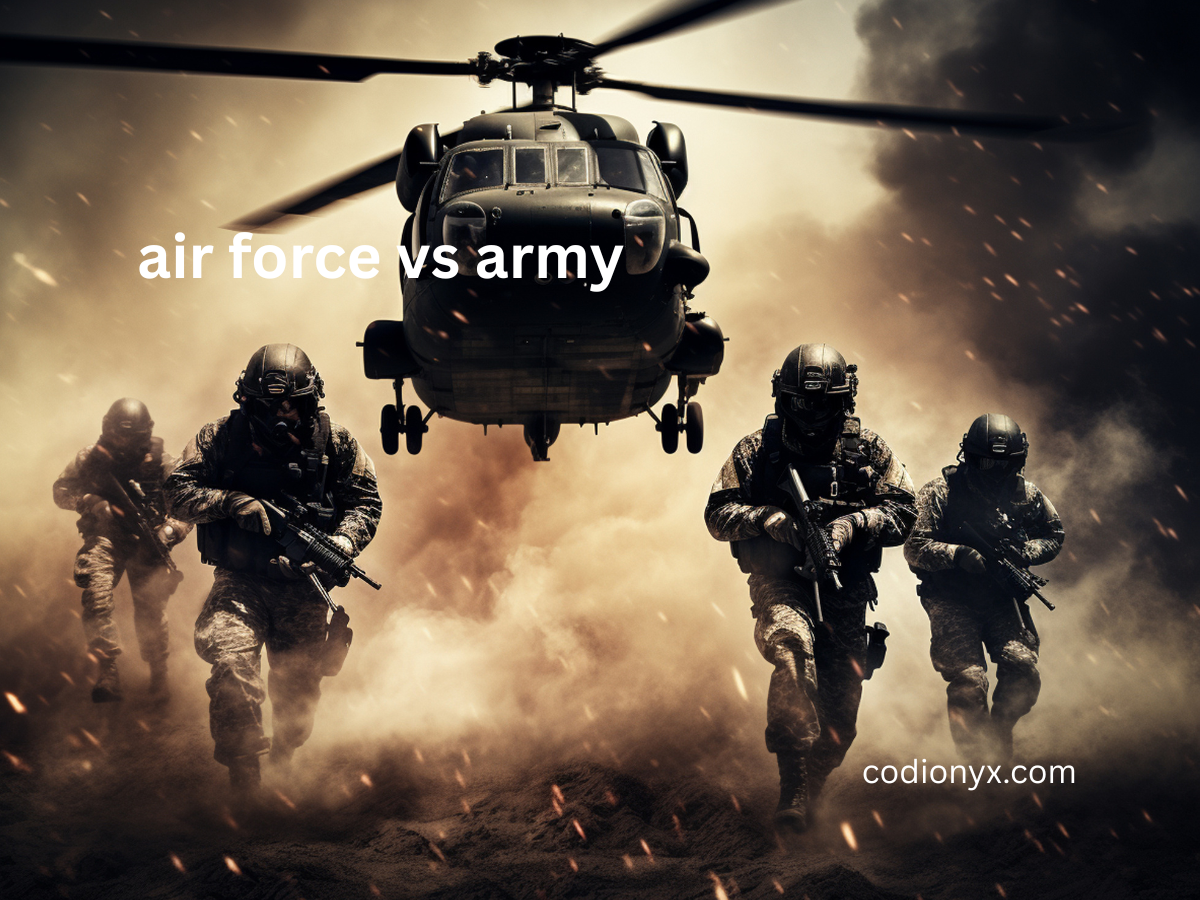Introduction
Air Force vs Army are two of the most prestigious and well-known branches in terms of military duty and national defence. Although they are both employed by the Department of Defence and strive to safeguard the country, their missions, training, lifestyles, positions, and responsibilities are very different.
This page explains the main distinctions and parallels between the Air Force vs Army, assisting you in better understanding their distinct roles and contributions, whether you’re thinking about a career in the military or are just interested in how these branches stack up.
1. History and Purpose
United States Army: Founded in 1775, the U.S. Army is the oldest branch of the American military. Its main goal is to use ground-based operations to safeguard and defend the nation. It is essential for fighting, humanitarian aid, disaster relief, and maintaining global stability during times of conflict and peace.
Core Mission: “To provide timely, sustained land dominance across the full range of military operations in order to fight and win our nation’s wars.”
United States Air Force: The U.S. Air Force, on the other hand, was founded later in 1947, following World War II. Due to the growing significance of air superiority, strategic bombing, and reconnaissance, it separated from the Army Air Corps and became a separate branch.
“To fly, fight, and win — airpower anytime, anywhere” is the core mission.
2. Principal Obligations
Army functions include: combat engineering; special forces and intelligence collection; ground combat; infantry and armoured vehicle operations; peacekeeping and stability operations; and cyber and electronic warfare.
Roles in the Air Force:
Airlift and cargo transportation;
Space operations and missile warning;
Cybersecurity and communication networks;
Air supremacy and aerial combat;
Strategic and tactical bombing;
The Air Force rules the skies and provides aerial support for operations, whilst the Army battles mostly on the ground.
3. Boot Camp and Training
Army Basic Training (BCT):
Focus: Weapon handling, team exercises, combat readiness, physical fitness, and field training;
Duration: around 10 weeks;
Environment: physically demanding and taxing, frequently in rough terrain.
Basic Military Training (BMT) in the Air Force:
Focus: classroom instruction, military discipline, physical training, and aeronautical principles; duration: approximately 8.5 weeks
Environment: Less physically demanding than Army BCT, but more academic and technical
Summary: Army training emphasizes tenacity and endurance, while Air Force training leans more on discipline, leadership, and technical abilities.
4. Way of Life and Everyday Activities In Air Force vs Army
Army Lifestyle:
Hard structure and regular physical labour;
More direct exposure to battle;
Frequently deployed to high-risk and isolated areas;
Lives in field conditions or forward operating bases;
Usually assigned to air bases with more advanced facilities
More technical or support positions with less field time;
More consistent work schedules and conditions;
A greater chance of modern housing and leisure amenities
5. Professional Growth and Prospects
Education and Specialisations:
While both branches provide educational opportunities, the Air Force is renowned for its technological job fields, which include intelligence analysis, cybersecurity, satellite communications, and aircraft maintenance.
Because of its size, the Army offers a wider range of positions, such as those in infantry, combat engineers, logistics, military police, and medicine.
Career Path and Promotion:
Although both services provide formal advancement pathways, the Army emphasises field performance, leadership, and combat preparedness, while the Air Force places more value on technical proficiency and academic accomplishments.
6. Deployment and Combat Risk Army:
Higher chance of deployment to combat zones
Increased vulnerability to ground incursions, explosives, and direct firefights
Air Force:
There is a lower likelihood of land combat; deployments frequently entail air patrols, support missions, or surveillance; and some positions (such as combat control or pararescue) require a lot of battle.
In conclusion, the Army is more battle-focused if you’re looking for hands-on combat experience. Despite being more focused on technology and assistance, the Air Force is still vital to war efforts.
7. Pay and Benefits
The Department of Defense’s pay scale, which is based on years of service and rank, establishes uniform salaries for all military branches.
However, particularly in high-demand industries like cybersecurity, avionics, or nuclear operations, the Air Force frequently provides greater retention bonuses and technical certifications.
Housing & Amenities: Army postings are operational but might not have all the contemporary amenities of Air Force sites; Air Force stations are frequently newer, cleaner, and cosier.
8. Technology and Equipment
The Air Force uses state-of-the-art radar, satellite, and communications technology in addition to operating sophisticated aircraft like F-22 Raptors, B-2 Bombers, and drones.
Army: Employs cutting-edge ground-based weapon systems and mobile radar units; depends on tanks, helicopters, drones, armoured vehicles, and small guns.
The Air Force’s focus on computing, innovation, and aerospace may appeal more to tech buffs.
9. Size and Scope
The Air Force is a smaller but more specialised arm of the military, whereas the Army is the largest in terms of active men.
As a result, the Army offers more promotions and a wider variety of jobs, but there is also more competition and possibly harder deployments.
Conclusion
Selecting between the Air Force vs Army is about what’s best for you, not which is “better.”
For people looking for a hands-on, active lifestyle, ground combat roles, and physical challenge, the Army is the perfect fit.
People that are drawn to aviation and technical subjects, appreciate organised workplaces, and have a technological bent would be well suited to the Air Force.
Any military operation’s defence and success depend on both branches. They frequently cooperate; for example, the Army may advance on the ground while the Air Force secures the skies. Both ultimately require dedication, self-control, and a willingness to serve the country with distinction.
FAQs
1. Which is more difficult, the Air Force vs Army?
Because of its combat roles and field environments, the Army is typically thought to be more physically demanding. The Air Force has simpler physical criteria and a greater emphasis on academics and technical skills.
2. Is it the Army or the Air Force that deploys more frequently?
The Army deploys more frequently and for longer periods of time, frequently in areas of ongoing conflict. The Air Force also deploys, although usually for operations involving logistics, support, or surveillance.
3. Is it possible to transfer from the Army to the Air Force?
Although it depends on requirements, credentials, and available slots, inter-service transfer makes it conceivable.
4. Which branch offers more wages?
All branches get the same base pay, which is determined by time service and rank. The Air Force might, however, provide greater incentives for tech positions.
5. Is life in the Army or the Air Force better?
Better facilities, work-life balance, and housing are all hallmarks of the Air Force. Army bases are more durable and designed with functionality rather than comfort in mind.
6. Is it simpler to advance in the Army or the Air Force?
Although promotion rates differ, the Army offers more positions and occasionally faster promotions in enlisted ranks due to its size.
7. Do both streams provide benefits for college education?
Indeed. Both provide student loan repayment plans, GI Bill benefits, and tuition aid.










